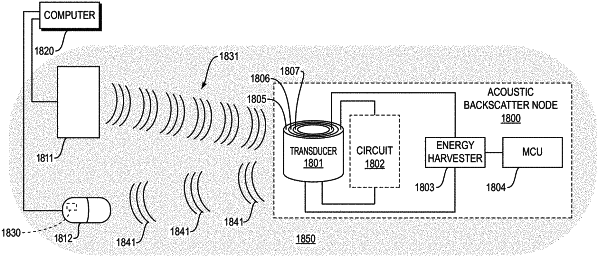| CPC H04R 1/44 (2013.01) [H04B 11/00 (2013.01); H04B 13/02 (2013.01); H04R 17/10 (2013.01); H04R 17/005 (2013.01)] | 10 Claims |

|
1. A system, comprising:
(a) an acoustic backscatter node, wherein
(i) the acoustic backscatter node includes an acoustic transducer, which acoustic transducer comprises a first set of two or more layers and a second set of one or more layers;
(ii) each layer in the first set of layers has a primary resonant frequency which differs, by at least five percent, from any primary resonant frequency of any other layer in the first set of layers;
(iii) each particular layer in the second set of one or more layers:
(a) is positioned between, touching, and attached to, certain layers of the first set of layers, and
(b) has a Young's modulus that is less than that of each of these certain layers; and
(iv) the acoustic transducer is configured in such a way that, when the layers in the first set of layers vibrate, coupling between the first and second sets of layers causes amplitude of vibration of the acoustic transducer to locally peak at multiple other frequencies, the amplitude of vibration at each of the other frequencies being larger than would otherwise occur if the coupling were absent;
(b) an acoustic transmitter configured to transmit an acoustic downlink signal at a first center frequency, which downlink signal travels to both the receiver and the acoustic backscatter node; and
(c) an acoustic receiver; and
wherein:
the acoustic backscatter node causes a shift in frequency by modulating the acoustic downlink signal in such a way that an acoustic uplink signal:
(i) reflects from the backscatter node at a second center frequency, which second center frequency is different from the first center frequency; and
(ii) travels to the receiver; and
the acoustic receiver performs analog filtering to filter out the downlink signal.
|